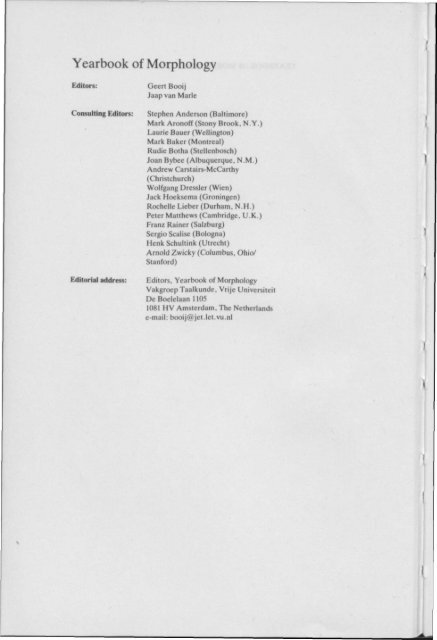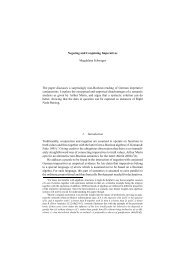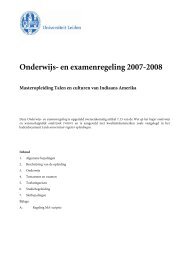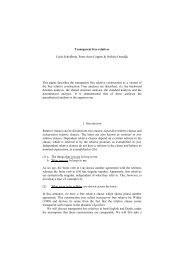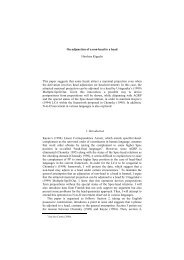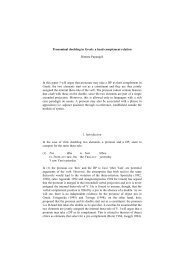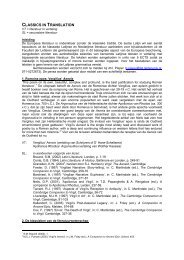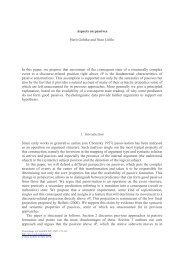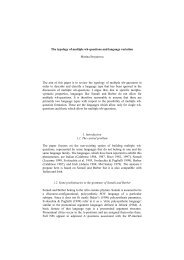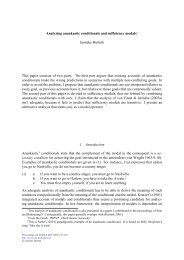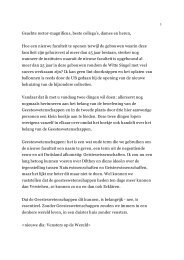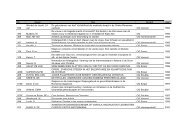Yearbook of Morphology
Yearbook of Morphology
Yearbook of Morphology
Create successful ePaper yourself
Turn your PDF publications into a flip-book with our unique Google optimized e-Paper software.
<strong>Yearbook</strong> <strong>of</strong> <strong>Morphology</strong><br />
Editors:<br />
Consulting Editors:<br />
Editorial address:<br />
Geert Booij<br />
Jaap van Marie<br />
Stephen Anderson (Baltimore)<br />
Mark Aron<strong>of</strong>f (Stony Brook, N.Y.)<br />
Laurie Bauer (Wellington)<br />
Mark Baker (Montreal)<br />
Rudie Botha (Stellenbosch)<br />
Joan Bybee (Albuquerque, N.M.)<br />
Andrew Carstairs-McCarthy<br />
(Christchurch)<br />
Wolfgang Dressler (Wien)<br />
Jack Hoeksema (Groningen)<br />
Rochelle Lieber (Durham, N.H. )<br />
Peter Matthews (C'ambridge, U.K.)<br />
Franz Rainer (Salzburg)<br />
Sergio Scalise (Bologna)<br />
Henk Schultink (Utrecht)<br />
Arnold Zwicky (Columbus, Ohio/<br />
Stanford)<br />
Editors, <strong>Yearbook</strong> <strong>of</strong> <strong>Morphology</strong><br />
Vakgroep Taalkunde. Vrije Universiteit<br />
De Boelelaan 1105<br />
1081 HV Amsterdam, The Netherlands<br />
e-mail: booijC« jet.let.vu.nl
YEARBOOK OF<br />
MORPHOLOGY<br />
1993<br />
Edited by<br />
GEERT BOOIJ<br />
General Linguistics, Free University, Amsterdam/Holland<br />
Institute <strong>of</strong> generative Linguistics<br />
JAAP VAN MARLE<br />
P.J. Meertens Institute <strong>of</strong> the Royal Academy <strong>of</strong> Sciences<br />
KLUWER ACADEMIC PUBLISHERS<br />
DORDRECHT / BOSTON / LONDON
ISSN 0922-3495<br />
ISBN 0-7923-2494-3<br />
Published by Kluwer Academic Publishers,<br />
P.O. Box 17, 3300 AA Dordrecht, The Netherlands.<br />
Kluwer Academic Publishers incorporates the publishing<br />
programmes <strong>of</strong> D. Reidel, Martinus Nijh<strong>of</strong>f, Dr W. Junk and MTP Press.<br />
Sold and distributed in the U.S.A. and Canada<br />
by Kluwer Academic Publishers,<br />
101 Philip Drive, Norwell, MA 02061, U.S.A.<br />
In all other countries, sold and distributed<br />
by Kluwer Academic Publishers Group,<br />
P.O. Box 322, 3300 AH Dordrecht, The Netherlands.<br />
Printed an mid-free paper<br />
All rights reserved<br />
© 1993 by Kluwer Academic Publishers<br />
No part <strong>of</strong> the material protected by this copyright notice may be reproduced or<br />
utilized in any form or by any means, electronic or mechanical,<br />
including photocopying, recording or by any information storage and<br />
retrieval system, without written permission from<br />
the copyright owner.<br />
Printed in the Netherlands
Table <strong>of</strong> contents<br />
THOMAS BECKER / Back-formation, cross-formation, and 'bracketing 1<br />
paradoxes' in paradigmatic morphology<br />
GEERT BOOIJ / Against split morphology 27<br />
ROCHELLE LIEBER and HARALD B AA YEN / Verbal prefixes in 51<br />
Dutch: a study in lexical conceptual structure<br />
JOHN J. MCCARTHY and ALAN PRINCE / Generalized Alignment 79<br />
CAROLINE SMITS / Resistance to erosion in American Dutch inflection 155<br />
RICHARD SPROAT and CHILIN SHIH / Why Mandarin morphology 185<br />
is not stratum-ordered<br />
IRENE VOGEL / Verbs in Italian morphology 219<br />
Short notice<br />
JAAP VAN MARLE / Morphological adaptation 255<br />
Book notices<br />
MARK ARONOFF / Peter Matthews, <strong>Morphology</strong>: An Introduction 267<br />
to Word Structure. Second edition<br />
GEERT BOOIJ / Sergio Scalise (ed.) The <strong>Morphology</strong> <strong>of</strong> Compounding 269<br />
MICHAEL HAMMOND / Andrew Spencer, Morphological Theory 269<br />
FRANZ RAINER / Yakov Malkiel, Diachronie Studies in Lexicology, 272<br />
Affixation and Phonology
Against split morphology<br />
GEERT BOOIJ<br />
1. INTRODUCTION<br />
The traditional distinction between inflection and derivation has been widely<br />
discussed in the morphological literature (cf. Plank 1981, Anderson 1982,<br />
1988a,b; 1992, Bybee 1985, Watters 1985, Scalise 1986, Badecker and<br />
Caramazza 1989, Dressier 1989). Anderson argues for a separation <strong>of</strong><br />
derivation and inflection in the grammar, where inflection is delimited from<br />
derivation by the following definition:<br />
(1) "Inflectional morphology is what is relevant to the syntax"<br />
(Anderson 1982: 587)<br />
This distinction is accounted for in the organization <strong>of</strong> the grammar by locating<br />
derivational rules in the lexicon, and inflectional rules in a post-syntactic<br />
component <strong>of</strong> spell-out rules that derive the correct form <strong>of</strong> words on the basis<br />
<strong>of</strong> their morpho-syntactic properties which are partially determined by<br />
syntactic rules <strong>of</strong> agreement and case assignment. The hypothesis that<br />
derivation and inflection are separated in the grammar is called the 'split<br />
morphology hypothesis' (Perlmutter 1988).<br />
As evidence for split morphology Anderson (1982: 610) adduces the<br />
observation that (regular) inflectional morphology is always peripheral with<br />
respect to derivational morphology, which is predicted by the proposed<br />
organization <strong>of</strong> the grammar. To put it differently, (regular) inflection cannot<br />
function as input for derivation.<br />
In this paper I will argue against the split morphology hypothesis by showing<br />
that inflection can feed word formation (both derivation and compounding). I<br />
will propose a distinction between two types <strong>of</strong> inflection, inherent inflection<br />
and contextual inflection, and show that it is only certain types <strong>of</strong> inherent<br />
inflection that can feed word formation. Section 2 introduces and motivates the<br />
distinction between inherent and contextual inflection. It appears that this<br />
distinction is also reflected by processes <strong>of</strong> lexicalization and language change,<br />
and by generalizations concerning affix ordering and agreement patterns. In<br />
section 3 I will provide evidence for the claim that inherent inflection can feed<br />
word formation, which thus refutes the split morphology hypothesis. In section<br />
4 it is shown that this generalization concerning the interaction <strong>of</strong> inflection and<br />
word formation cannot be expressed by splitting inflection into two<br />
components (inherent inflection in the lexicon, and contextual inflection in a<br />
post-syntactic component <strong>of</strong> spell-out rules). Instead, we need substantive<br />
constraints on the interaction <strong>of</strong> inflection and word formation. Such<br />
constraints are proposed in section 5.<br />
Geert Boosj and Jaap van Marie (ed.\. ), <strong>Yearbook</strong> <strong>of</strong> <strong>Morphology</strong> IW3, 27-49,<br />
© 1993 Kliiwer Academic l'nhlt\lu'n /Vm/n/ in the Netherlands<br />
27
28 Geert Booij<br />
2. INHERENT AND CONTEXTUAL IN F LECTION<br />
Anderson (1988a: 25, 1988b; 167-168) provides the following classification <strong>of</strong><br />
inflectional categories:<br />
(2) a. configurational categories (e.g. case marking on nouns), assigned<br />
on the basis <strong>of</strong> the larger structure in which the word appears<br />
b. agreement categories (aspect <strong>of</strong> a word's form determined by other<br />
words in the same structure)<br />
c. phrasal categories (e.g. case marking <strong>of</strong> an NP realized on its<br />
nominal head<br />
d. inherent categories (e.g. number <strong>of</strong> nouns)<br />
1 will refer to the categories (2a-c) as contextual inflection, and to the category<br />
(2d) as inherent inflection.<br />
There are also inherent morpho-syntactic properties <strong>of</strong> words that are not<br />
expressed morphologically on these words, but do play a role in contextual<br />
inflection. For instance, gender is an inherent morphosyntactic category for<br />
Dutch nouns, but it is not an inflectional category for this word class: the gender<br />
<strong>of</strong> nouns only plays a role in contextual inflection.<br />
In Anderson's theory <strong>of</strong> inflection, the inherent morpho-syntactic features <strong>of</strong><br />
words are generated by Complex Symbols creating rules such as<br />
(3) N-» [a plu, ßneutj<br />
(where [plu] is the feature for the category number, and [neut] the feature for<br />
the category gender). Contextually determined morphosyntactic features will<br />
be assigned by syntactic rules <strong>of</strong> case assignment, agreement, etc.. At the level<br />
<strong>of</strong> surface structure each lexical node possesses an array <strong>of</strong> relevant<br />
morphosyntactic features, on which the spell out rules operate. The array <strong>of</strong><br />
features is in essence an unordered list, except for features for subject and<br />
object agreement (w.r.t. number and person) which may appear in a layered<br />
structure. For instance, an N node may contain both a feature for case and for<br />
number, without any indication <strong>of</strong> the fact that the number feature is inherent,<br />
and the case feature assigned by a syntactic rule. In other words, Anderson's<br />
theory does not predict anything about the order <strong>of</strong> inflectional affixes,<br />
although there are certainly cross-linguistic generalizations tobe made here, as<br />
will be shown below, a point also made in Baker (1991).<br />
Thus, the organizational model <strong>of</strong> the grammar that Anderson proposes is<br />
the following (from Anderson 1982: 594).
Against split morphology 29<br />
(4)<br />
Base Rules (and<br />
development <strong>of</strong><br />
inherent features)<br />
D-structures<br />
I<br />
Syntax (Move a,<br />
configurations] and<br />
agreement, etc.,<br />
marking rules)<br />
1<br />
S-structures (incl.<br />
morphosyntactic representations)<br />
Lexical Items (stems)<br />
Lexically interpreted S-structures<br />
^<br />
"Phonology"<br />
(incl. stylistic<br />
rules, inflection,<br />
phonology proper)<br />
1<br />
[Phonological Form]<br />
Logical Form<br />
It should be realized that there is no reason why inherent inflection (i.e. the<br />
morphological expression <strong>of</strong> inherent morpho-syntactic properties) should be<br />
spelled out post-syntactically, together with contextual inflection. Lexical<br />
items could also be inherently inflected in the lexicon, and then be inserted (in<br />
D-structure or in S-structure). This latter option (inherent inflection in the<br />
lexicon) is even the only possible one if syntactic structure is not generated by<br />
rewriting rules (including the rules that expand lexical nodes into complex<br />
symbols, which are arrays <strong>of</strong> inherent morpho-syntactic properties), but is seen<br />
as the projection <strong>of</strong> properties <strong>of</strong> lexical items.<br />
In order to make the discussion more concrete, let me first give a survey <strong>of</strong><br />
inherent inflection versus contextual inflection for Dutch:
30 Geert Booij<br />
(5) Inherent Contextual<br />
N number<br />
A comparative, superlative number + gender + definiteness<br />
V infinitive, participles, tense number 4- person<br />
(the + indicates that these categories are expressed simultaneously by one<br />
morph). Traditionally, all the categories mentioned here are considered<br />
inflectional categories. Nevertheless, there is a clear difference in semantic<br />
content between inherent inflection and contextual inflection. Inherent<br />
inflection expresses, like derivation, a certain amount <strong>of</strong> independent<br />
information, whereas the information expressed by contextual inflection is<br />
redundant, and only reflects certain aspects <strong>of</strong> the syntactic structure <strong>of</strong> the<br />
sentence.' For instance, the marking <strong>of</strong> a noun as plural is not predictable on<br />
the basis <strong>of</strong> syntactic structure, whereas the plural marking <strong>of</strong> the finite verbis,<br />
once the subject has been identified. 2<br />
Kurytowicz (1964) also observed these differences. He distinguished<br />
between inflectional categories with a primarily syntactic function such as case,<br />
and inflectional categories with a primarily semantic or autonomous function. 1<br />
For instance, he pointed out that number is a "semantic trait <strong>of</strong> the noun (p.<br />
31), and that "[d]egrees <strong>of</strong> comparison [...] represent the autonomous<br />
inflection <strong>of</strong> the adjective. This inflection is intrinsically semantic and never<br />
assumes a special syntactic function" (p. 34). Therefore, both Kurytowicz<br />
(1964: 37) and Bybee (1985: 87) concluded that the difference between<br />
inflection and derivation is only a matter <strong>of</strong> degree. Bybee pointed out that for<br />
nouns, the morphological expression <strong>of</strong> number is more like derivation, unlike<br />
that <strong>of</strong> case and definiteness: "case and definiteness have no effect on the<br />
inherent qualities <strong>of</strong> the entity or the entities being referred to, while number<br />
does" (Bybee 1985: 85). In other words, it is cases <strong>of</strong> inherent inflection that<br />
Bybee adduces to support the position that the differences between derivation<br />
and inflection are a matter <strong>of</strong> degree (Bybee 1985: 87).<br />
It should also be observed that inherent inflection changes the meaning <strong>of</strong><br />
words: a singular noun differs in meaning from a plural noun, and a<br />
comparative form <strong>of</strong> an adjective has a meaning other than that <strong>of</strong> its base<br />
form. 4 In the case <strong>of</strong> infinitives and participles even change <strong>of</strong> syntactic<br />
category is involved since infinitives behave simultaneously as verbs and as<br />
nouns, not only as verbs, and participles have adjectival properties besides<br />
verbal properties.<br />
Tense is also an inherent property <strong>of</strong> verbs, i.e. the tense <strong>of</strong> the verb is not<br />
determined by syntactic structure. 5 The meaning <strong>of</strong> tense is a deictic/referential<br />
one: tense has scope over a whole clause, and locates the time <strong>of</strong> the state or<br />
action expressed by the sentence with respect to the time <strong>of</strong> speaking (Jakobson<br />
1957, Kurytowicz 1964: 24). In embedded clauses tense may be determined by<br />
that <strong>of</strong> the main clause (sequence <strong>of</strong> tense). However, Kurytowicz (1964: 24)<br />
pointed out that this is a secondary (syntactic) use <strong>of</strong> tense. But even in that<br />
case, there is a choice for the speaker. Compare the following sentences:
(6) a. John told us that he was ill<br />
b. John told us that he is ill<br />
Against split morphology 31<br />
These sentences show that sequence <strong>of</strong> tense is only to be used if one wants to<br />
express that John was ill at the moment <strong>of</strong> his speaking, whereas in (6b) John<br />
is still ill at the moment that the sentence is uttered.<br />
Although 'gender' is mentioned as a case <strong>of</strong> contextual inflection for<br />
adjectives, it is not mentioned as a case <strong>of</strong> inherent inflection for nouns in (5).<br />
The reason for this is that gender, although a relevant morphosyntactic<br />
category, is not directly expressed by means <strong>of</strong> inflection in Germanic<br />
languages. The gender <strong>of</strong> simplex nouns is quite <strong>of</strong>ten arbitrary from the<br />
synchronie point <strong>of</strong> view, and in complex words it may be determined by the<br />
derivational suffixal head. For instance, all diminutives in Dutch and German<br />
are neuter due to the presence <strong>of</strong> the diminutive suffix. Even in languages with<br />
declensional classes, the element characteristic <strong>of</strong> a class is not a direct<br />
morphological expression <strong>of</strong> gender. For instance, although most Latin nouns<br />
in -a are feminine, some <strong>of</strong> them (e.g. nauta 'sailor') are masculine, and hence<br />
there is only an indirect relation between gender and inflectional elements such<br />
as class markers (cf. Aron<strong>of</strong>f 1991).<br />
<strong>Morphology</strong> handbooks such as Matthews (1974: 46ff) and Bauer (1983: 24)<br />
also point out that it is only what I call contextual inflection that can be<br />
straightforwardly demarcated from derivation, whereas the difference<br />
between what I call inherent inflection and derivation is gradual.<br />
I will now discuss some phenomena that reflect the differences between these<br />
two kinds <strong>of</strong> inflection.<br />
2.7. Lacking forms<br />
Bybee (1985) points out that number for nouns is more like derivation in that<br />
English has many nouns with only a singular or plural form, whereas a 'real'<br />
inflectional category must have full lexical generality (p. 84). The same point<br />
was made by Beard (1982). It also applies to Dutch nouns: in addition to the<br />
well-known pluralia tantum such as notulen 'minutes' and Alpen 'Alps' there<br />
are many nouns that lack a plural form, in particular mass nouns, abstract<br />
nouns, and proper names such as the names <strong>of</strong> the months, in short, non-count<br />
nouns: 6<br />
(7) aplomb 'id.', arbeid 'labour', antiek 'antiques', genade 'grace',<br />
goud 'gold'. Maart 'March', verzekerdheid 'assuredness'<br />
In this respect nouns differ from verbs which usually have a complete<br />
paradigm, although occasional defective verbal paradigms have been observed<br />
(for instance, for Russian by Halle 1973).<br />
Adjectives behave similarly to nouns in that there are also adjectives that<br />
lack certain inherent inflectional forms. For instance, certain adjectives that<br />
express a non-gradable quality (gouden 'golden', dood 'dead', oneindig<br />
'infinite', dagelijks 'daily', mondeling 'oral', hypermodern 'very modern') do
32 Geert Booij<br />
not have comparative and superlative forms. Vice versa, certain adjectives only<br />
occur in a superlative form, i.e. the positive degree and the comparative degree<br />
are lacking: 7<br />
(8) onder-st 'lowest', boven-st 'uppermost', uiter-st 'most extreme',<br />
voor-st 'most forward', achter-st 'most backwards', middel-st<br />
'middle'<br />
There are also many participles in Dutch that lack a verbal base, for instance:<br />
(9) getogen 'educated', geboren 'born', belabberd 'bad', geronnen<br />
'clotted', geoorlo<strong>of</strong>d 'permitted', geparenteerd 'related'<br />
In this respect they resemble derived words that contain an affix, but do not<br />
have an identifiable lexical item as their base, the so-called formally complex<br />
words (cf. Booij 1977: 29-30).<br />
2.2 Inflectional split<br />
The differences between nominal and verbal number as inherent versus<br />
contextual inflection is also reflected by their differential behaviour with<br />
respect to inflectional split, the phenomenon that inflectionally related word<br />
forms receive different interpretations: we find inflectional split for singular<br />
versus plural nouns, but not for singular verb forms versus plural verb forms.<br />
Examples <strong>of</strong> inflectional split are the following:<br />
(10) English<br />
brother<br />
cloth 'woven material'<br />
Dutch<br />
vader 'father'<br />
letter'id.'<br />
zenuw 'nerve'<br />
brethren 'members <strong>of</strong> a religious<br />
community'<br />
clothes 'garments'<br />
vaderen 'forefathers'<br />
letteren'Arts'<br />
zenuwen 'a fit <strong>of</strong> nerves'<br />
This observation supports the idea that inherent inflection is more like<br />
derivation since derived words may also have a semantically partially opaque<br />
relation to their base words.<br />
2.3. Deflection<br />
Inherent and contextual inflection behave differently in case <strong>of</strong> deflection.<br />
Kiparsky (1972: 92) already observed that in the case <strong>of</strong> nominal paradigms<br />
grammatical case is weaker than pluralization in that "lost plural distinctions<br />
are more likely to be analogically restored than lost [grammatical] case<br />
distinctions". Kiparsky also distinguished between weak inflection<br />
(grammatical case and verbal agreement in non-Pro drop-languages) versus
Against split morphology 33<br />
strong inflection (number, tense, gender and verb agreement in Pro droplanguages),<br />
where 'weak' means 'easily subject to morphological erosion'.<br />
Kiparsky concluded: "Evidently the weak categories are those which register<br />
information that is relatively redundant" (Kiparsky 1972: 99). It will be clear<br />
that Kiparsky's distinction between weak and strong inflection coincides with<br />
that between contextual and inherent inflection.<br />
The generalization that nominal and verbal pluralization behave differently<br />
when a language is subject to deflection can also be illustrated for Afrikaans. In<br />
Afrikaans, a daughter <strong>of</strong> Dutch, the morphological expression <strong>of</strong> number and<br />
person on verbs has been lost completely, whereas number is still expressed<br />
systematically on nouns. For verbs, the tense distinctions <strong>of</strong> Dutch are<br />
preserved although past tense is now expressed by a periphrastic form<br />
(auxiliary -I- past participle), the formal equivalent <strong>of</strong> the Dutch present perfect<br />
form. This pattern <strong>of</strong> deflection is understandable given the different functions<br />
<strong>of</strong> noun pluralization and verb pluralization: it is only the latter which, due to<br />
its contextual nature, is redundant, and hence can be more easily omitted.<br />
Given its independent deictic function, tense is expected to be preserved, as is<br />
indeed the case.<br />
Interestingly, the same differentiation is found in the deflection processes <strong>of</strong><br />
American Dutch (Van Marie and Smits 1992). Van Marie and Smits found for<br />
all the different varieties <strong>of</strong> American Dutch that pluralization <strong>of</strong> nouns is<br />
stable, whereas the verbal system has been strongly deflected in that number<br />
and person distinctions have been lost. As is to be expected if tense is a case <strong>of</strong><br />
inherent inflection, tense may behave differently from number and person<br />
under deflection. In Old New York Dutch, person and number are lost, while<br />
the past tense forms are maintained and regularized. This does not mean that<br />
tense distinctions are never lost in deflection processes, but that there is a clear<br />
difference here between the categories <strong>of</strong> person and number versus the<br />
category <strong>of</strong> tense in that person and number distinctions are lost much more<br />
easily. In some varieties <strong>of</strong> American Dutch we also find the infinitive form as<br />
the general form for all persons and both numbers, i.e. the infinitive form, a<br />
case <strong>of</strong> inherent inflection, is maintained.<br />
A similar situation obtains for situations <strong>of</strong> language death. Dorian (1981)<br />
reports for Scottish Gaelic that case and verbal number are highly unstable, but<br />
that nominal number is stable. Tense (and passive) morphology are<br />
maintained. In young people's Dyirbal (Schmidt 1985) case markers, some<br />
tense markers and other verbal inflectional markers tend to disappear, but<br />
some mood and aspect markers survive, i.e. contextual inflection is to a far<br />
more higher degree subject to morphological erosion.<br />
In recent work on the evolution <strong>of</strong> the nominal paradigm in medieval Dutch<br />
Mary nissen (1992) found that in the phonological restructuring <strong>of</strong> nominal<br />
paradigms maintenance <strong>of</strong> the distinction between singular and plural is given<br />
priority above maintaining case distinctions, in line with the observations given<br />
above. Similar findings were already reported in Kiparsky (1972). Romance<br />
languages such as French, Italian, and Spanish also illustrate this point: they
34 Geert Booij<br />
lost case, but kept number as an inflectional category.<br />
Another relevant observation is that in Afrikaans the other types <strong>of</strong> inherent<br />
inflection listed in (5), comparatives, superlatives, infinitives and participles<br />
are all maintained. On the other hand, the contextual inflection <strong>of</strong> adjectives,<br />
like that <strong>of</strong> verbs, has been subject to change. In the original Dutch system, a<br />
suffix -e is added to an attributively used adjective unless the NP in which the<br />
adjective occurs has the morphosyntactic features [-def, -plu, -neut]. In the<br />
system <strong>of</strong> Afrikaans, this system has changed and demorphologized: the<br />
addition <strong>of</strong> -e in attributive position is determined by the phonological make up<br />
<strong>of</strong> the adjectives, and is partially also lexically governed (Barnes 1991,<br />
Combrink 1990, Lass 1990).<br />
2.4. Lexicalization<br />
Above I pointed out that plural forms <strong>of</strong> nouns may have idiosyncratic<br />
interpretations. This also applies to inherently inflected forms <strong>of</strong> adjectives and<br />
verbs. Note, however, that this does not apply to tensed verbal forms.<br />
Some comparative and superlative forms <strong>of</strong> adjectives have idiosyncratic<br />
interpretations:<br />
(11) comparatives:<br />
heter (lit. better)<br />
ouder (lit. older)<br />
later (lit. later)<br />
superlatives:<br />
best (lit. best)<br />
present participles:<br />
ontzettend (lit. appalling)<br />
woedend (lit. raging)<br />
past participles:<br />
bezeten (lit. possessed)<br />
gelikt (lit. licked)<br />
gesmeerd (lit. greased)<br />
getikt (lit. tapped)<br />
hervormd (lit. reformed)<br />
gereformeerd (lit. reformed)<br />
infinitives:<br />
bestaan (lit. exist)<br />
wezen (lit. be)<br />
eten (lit. eat)<br />
drinken (lit. drink)<br />
'healthy again'<br />
'parent'<br />
'in the future'<br />
'good, o.k.'<br />
'very'<br />
'very angry'<br />
'mad'<br />
'slick'<br />
'smoothy'<br />
'crazy'<br />
'Protestant'<br />
'Protestant'<br />
'existence'<br />
'essence'<br />
'food'<br />
'drinks'<br />
The fact that infinitives can so easily lexicalize into nouns was also pointed<br />
out for the Romance languages by Malkiel (1978), for instance:
Against split morphology 35<br />
(12) French: repentir'repentance', parler'dialect', devoir<br />
'duty', pouvoir 'power'<br />
Rumanian: lucrare 'work', durere 'pain', sosire 'arrival',<br />
intindere 'extension'<br />
Malkiel used these observations to illustrate the point that derivation and<br />
inflection cannot be sharply distinguished.<br />
The fact that lexicalization clearly distinguishes between inherent and<br />
contextual inflection suggests once more that inherent inflection is more like<br />
derivation, which is also subject to lexicalization.<br />
2.5. Affix order<br />
Generalizations concerning the order <strong>of</strong> inflectional suffixes can partially be<br />
stated in terms <strong>of</strong> the distinction between contextual inflection and inherent<br />
inflection: contextual inflection tends to be peripheral with respect to inherent<br />
inflection. For instance, when case and number are expressed by different<br />
suffixes, the case suffix is peripheral w.r.t. the number suffix. Greenberg (1963)<br />
gives this generalization as Universal 39.<br />
(13) "Universal 39. Where morphemes <strong>of</strong> both number and case are<br />
present and both follow or both precede the noun base, the<br />
expression <strong>of</strong> number almost always comes between the noun base<br />
and the expression <strong>of</strong> case." (Greenberg 1963: 95)<br />
Similarly, Bybee (1985: 24) remarked with respect to the expression <strong>of</strong> verbal<br />
inflectional categories that the expressions for number agreement, person<br />
agreement and gender agreement, i.e. the contextual inflectional categories,<br />
are peripheral to the morphological expressions <strong>of</strong> valence, voice, aspect,<br />
tense, and mood, i.e. the inherent inflectional categories <strong>of</strong> the verb.<br />
Yet, contextual inflection is not always peripheral to inherent inflection. For<br />
instance, in Welsh Romany the imperfect suffix -s always follows the subject<br />
agreement suffix, as in the following forms from the paradigm <strong>of</strong> kam 'to love': 8<br />
(14) Present Imperfect<br />
Sg PI Sg PI<br />
1 kamâva karnasa kamava-s kamasa-s<br />
2 kamésa kaména kamésa-s kaména-s<br />
3 kaméla kaména kaméla-s kaména-s<br />
This implies that it is not possible to account for the tendency that contextual<br />
inflection is peripheral to inherent inflection in terms <strong>of</strong> a model <strong>of</strong> the<br />
organization <strong>of</strong> the grammar in which inherent inflection is located in the<br />
lexicon, and contextual inflection in a post-syntactic component <strong>of</strong> spell out<br />
rules.
36 Geert Booij<br />
2.6. Agreement<br />
Agreement phenomena also reflect the difference between inherent and<br />
contextual inflection. For instance, whereas case, a case <strong>of</strong> contextual<br />
inflection, plays a role in agreement between specifiers and heads within NP's,<br />
it is a rare phenomenon across languages to have case agreement between<br />
relative pronouns and their antecedents, which only agree with respect to<br />
inherent morpho-syntactic properties such as gender and number. Comrie<br />
(1981: 147) mentions Ancient Greek as a language in which the case <strong>of</strong> the<br />
antecedent can be transferred to the relative pronoun, so-called 'attraction'.<br />
That this is a marked phenomenon is also clear from the fact that case attraction<br />
can also work the other way round, as in Persian where, according to Comrie,<br />
the subject <strong>of</strong> the main clause can be marked as direct object if it is the<br />
antecedent <strong>of</strong> a relative pronoun that functions as direct object in the relative<br />
clause.<br />
In sum, agreement phenomena support the distinction between inherent and<br />
contextually determined morpho-syntactic properties. The observations given<br />
here are also in conformity with Corbett's (1979) agreement hierarchy<br />
(15)<br />
attributive - predicate - relative pronoun - personal pronoun<br />
in which the possibility <strong>of</strong> syntactic agreement decreases monotonically from<br />
left to right, and, inversely, the possibility <strong>of</strong> semantic agreement increases,<br />
since agreement w.r.t. inherent morpho-syntactic categories is more <strong>of</strong> a<br />
semantic nature than agreement with respect to contextually determined,<br />
semantically empty, properties.<br />
3. INHERENT INFLECTION AS INPUT FOR WORD FORMATION<br />
In this section, I will show that inherent inflection may feed word formation,<br />
which leads to the conclusion that the split morphology hypothesis cannot be<br />
right.<br />
3.1. Plural nouns and word formation<br />
Dutch appears to be one <strong>of</strong> the languages in which plural nouns can function as<br />
input for compounding, as in the following examples (cf. also Booij 1977: 48,<br />
1992):<br />
(16) steden-raad 'cities council' (vs. stadsraad 'city council')<br />
minderheden-beleid 'minorities policy'<br />
huizen-rij 'row <strong>of</strong> houses'<br />
daken-zee 'sea <strong>of</strong> ro<strong>of</strong>s'<br />
jongemannen-vereniging 'young men's association'
Against split morphology 37<br />
Note that head constituents like rij, zee en verenigingeven require a plural nonhead<br />
given the meaning <strong>of</strong> these words. Similar compounds have been<br />
observed for English (Dierickx 1970, Selkirk 1982: 52, Dressier 1989), e.g.<br />
arms race, parts distributor, buildings inspector, news man, sports woman,<br />
clothes press, roads program, universities yearbook, suggestions box. Note that<br />
it is not only irregularly inflected nouns that form inputs for compounding, as<br />
was claimed by Kiparsky (1982) in his level-ordered approach <strong>of</strong> English<br />
morphology in which irregular inflection is ordered before, and regular<br />
inflection is ordered after compounding. For instance, in buildings inspector,<br />
the word buildings is a regular plural noun. y<br />
However, one might argue that the occurrence <strong>of</strong> plural nouns in non-head<br />
position does not prove that nominal inflection feeds word formation, since an<br />
alternative analysis is available: phrases have to be allowed as non-headconstituents<br />
<strong>of</strong> compounds (Booij 1992, Lieber 1992), as illustrated here for<br />
Dutch, and thus we can also have NP's as left constituents <strong>of</strong> compounds that<br />
contain a plural noun only:<br />
(17) [drie landen] N p punt 'place where three countries meet'<br />
[oude mannen] N p huis 'old men's home<br />
[hete lucht] N |. ballon 'hot air balloon'<br />
In the first two examples the words landen en mannen are plural nouns. Note<br />
that we also find contextual inflection within such word-internal NP's, for<br />
instance the final -e <strong>of</strong> hete in heteluchtballon.<br />
The fact that plural nouns in the non-head position <strong>of</strong> compounds do not<br />
occur as frequently as (seemingly) singular nouns has to do with the fact that<br />
compound-internal nouns without an explicit number inflection should not be<br />
seen as singular nouns, but rather as nominal stems which are unspecified for<br />
number. For instance, in the compound boekverkoper 'book seller' the nonhead<br />
boek should not be interpreted as singular noun, but rather as an<br />
unspecified one: clearly, a bookseller normally sells more than one book, but<br />
this need not be specified.<br />
Italian also has a productive class <strong>of</strong> (exocentric) compounds containing<br />
plural nouns (cf. Zuffi 1981 )<br />
(18) lavapiatti 'dish washer' (piatti = plates)<br />
portalettere 'post man' (lettere = letters)<br />
rompiscatole 'brain twister' (scatole = brains)<br />
giradischi 'record player' (dischi = records)<br />
portaombrelli 'umbrella stand' (ombrelli = umbrellas)<br />
The same type <strong>of</strong> compound is found in Spanish (Sadock 1991: 158)<br />
(19) tuca discos'record player'<br />
limpia botas 'bootblack'<br />
Note that in these cases the plural noun cannot be interpreted as an NP since<br />
NP's are not allowed in that position. For instance, in Italian we cannot form
38 Geert Booij<br />
porta grandi ombrelli besides portaomhrelli (Scalise 1992: 195) as would be<br />
expected if the second constituent had phrasal status.<br />
Plural nouns do not only occur in compounds, but also in derived words. This<br />
was observed for Dutch in Booij (1977: 48) where the following examples are<br />
given <strong>of</strong> plural nouns to which the collective suffix -dom has been attached:<br />
(20) scholieren-dom 'the set <strong>of</strong> pupils', ploerten-dom 'the set <strong>of</strong> cads',<br />
muzikanten-dom 'the group <strong>of</strong> musicians'<br />
The plural forms involved here are regular ones, and the process is productive.<br />
For West-Frisian, a regional dialect <strong>of</strong> Dutch, Pannekeet (1979) gave<br />
examples such as moufjes-ig 'fond <strong>of</strong> girls (< moidjes 'girls') and peerdjes-e 'to<br />
play horse' (< peerdjex 'horses'). The latter example is a case <strong>of</strong> conversion:<br />
plural nouns can be converted into a verbal stem. Other examples are: pakkiese<br />
'to make packets' and klussiese 'to do all kinds <strong>of</strong> chores'." 1<br />
Bochner (1984) also argued that inflection cannot be completely separated<br />
from derivation, as Anderson would have it. Of his three cases two are no<br />
doubt cases <strong>of</strong> inherent inflection that feed derivation. According to Bochner,<br />
Yiddish plural nouns can serve as input for diminutive formation and adverb<br />
formation. However, Perlmutter (1988) argued that this only holds for<br />
irregular plural formations which for that reason have to be listed in the<br />
lexicon, and hence can feed word formation. Perlmutter argues that therefore<br />
the Yiddish data do not form counterexamples to the Split <strong>Morphology</strong><br />
Hypothesis that claims that (regular) inflection is separated from derivation,<br />
and dealt with in a separate, post-syntactic component.<br />
Even if Perlmutter were right with respect to Yiddish, it is clear from the<br />
above examples that it cannot be considered as a generally valid condition that<br />
only irregular inflectional forms serve as input for word formation. This is also<br />
shown by Stump (1990) who observed that the Breton diminutive suffix cannot<br />
only be attached to singular nouns, but also to regularly inflected plural nouns.<br />
Moreover, the comparative and superlative forms <strong>of</strong> adjectives, two other<br />
cases <strong>of</strong> inherent inflection, can also be diminutivized (data from Stump 1990):<br />
(21) singular diminutive plural plural diminutive<br />
bag'boat' bagig bagou bagoùigoù<br />
tra 'thing' traig traoù traoùigoù<br />
paotr'boy' paotrig paotred paotredigoù<br />
(22) bras 'big', brasoc'h 'bigger', brasoc'hik 'a little bigger', brasan<br />
'biggest', brasaikan 'biggest by a little'<br />
Breton plural nouns feed two other derivational processes, the formation <strong>of</strong><br />
denominal verbs in -in and -a, and the formation <strong>of</strong> denominal adjectives derived<br />
by the suffix -ek:<br />
(23) botez'shoe' botoù'shoes' botaouin 'to make shoes'<br />
aval'apple' avalou 'apples' avalaoua'to look for apples'<br />
delienn'leaf' deliou'leaves' deliaouek'leafy'
Against split morphology 39<br />
Note that in (21) pluralization occurs twice, i.e. it applies recursively. The<br />
possibility <strong>of</strong> recursive application is <strong>of</strong>ten considered as a characteristic<br />
property <strong>of</strong> derivation as opposed to inflection (Dressier 1989). It appears that<br />
in Breton pluralization <strong>of</strong> nouns can apply twice anyway (Stump 1990: 115):<br />
(24) Sg PI Double PI<br />
bugel 'child' bugale bugaleoù<br />
gavr 'goat' gevr gevred<br />
loen 'beast' loened loenedou<br />
ronse 'horse' ronsed ronsedoù<br />
Similarly, Bauer (1983: 26) observed that in Portuguese, plural is sometimes<br />
marked twice in diminutives, just as in the Breton words in (23).<br />
3.2. Infinitives and word formation<br />
Infinitives in Dutch appear to feed word formation, both compounding and<br />
derivation. In compounds they can occur both as left constituents (i.e. in the<br />
non-head-position) and as right constituents, i.e. as heads:<br />
(25) a. Infinitives in non-head position:<br />
lijden-s-verhaal 'Passion'<br />
zien-s-wijze 'point <strong>of</strong> view'<br />
bcstaan-s-grond 'reason for existence'<br />
eten-s-tijd 'dinner time'<br />
slapen-s-tijd 'bed time'<br />
sterven-s-begeleiding 'terminal care'<br />
Infinitives in head-position:<br />
school-zwemmen 'school-swimming'<br />
boek-binden 'book-binding'<br />
hout-hakken 'wood-chopping'<br />
touw-trekken 'rope-pulling'<br />
Infinitives have an ambiguous character in that they have both verbal and<br />
nominal properties. In the examples (25a) the presence <strong>of</strong> the linking phoneme<br />
,v reflects this nominal character. The examples (25b) belong to a productive<br />
morphological category although the formation <strong>of</strong> verbal compounds is<br />
unproductive in Germanic languages, again because infinitives also pattern like<br />
nouns (Booij 1989). "<br />
The use <strong>of</strong> the infinitival form instead <strong>of</strong> the verbal stem has to do with the<br />
fact that the infinitive form functions here as verbal nominalization. In Dutch,<br />
the déverbal nominalizing suffix is -ing, but this suffix hardly ever attaches to<br />
underived verbs. For these verbs, the infinitive form is the only possible form<br />
<strong>of</strong> nominalization: nouns like *lijding, *eting, *slaping and *sterving are ill<br />
formed. Therefore, verbal infinitives do not occur in the non-head position<br />
when derived verbs are involved, for which -ing is available. For instance,
40 Geert Booij<br />
Dutch has begroetingsceremonie 'greeting ceremony' rather than<br />
*begroetceremonie because the derived verb begroeten allows for<br />
nominalization with -ing.<br />
The possibility <strong>of</strong> infinitives feeding compounding is by no means an<br />
exclusive property <strong>of</strong> Dutch. It also occurs in other Germanic languages, and<br />
in a non-Indo-European language such as Finnish. In Finnish, only non-finite<br />
forms <strong>of</strong> verbs can occur in the left, non-head position <strong>of</strong> compounds (Sulkala<br />
and Karjalainen 1992: 362):<br />
(26) ampu-ma-rata 'shoot-INF-range, rifle-range'<br />
liikku-ma-tila 'move-INF-space, manoeuvring space'<br />
maa-ta-pano 'lie-INF-put+deriv. suffix, bed time'<br />
In Dutch, infinitives can also feed derivation with -er and -ing but this is a<br />
marginal phenomenon, only occurring with some special infinitives with the<br />
inflectional ending /n/ (normally, the inflectional ending is /r)n/:<br />
(27) doen /du-n/ 'to do' doen-er 'active person', doen-ing 'business'<br />
zien /zi-n/ 'to see' zien-er 'seer', voor-zien-ing 'provision'<br />
Summarizing, there is substantial evidence that infinitival forms feed word<br />
formation.<br />
3.3. Participles<br />
In Dutch, present and past participles feed word formation, both compounding<br />
and derivation. That is, their morphological distribution is that <strong>of</strong> adjectives, as<br />
is to be expected since they have to be considered as verbal adjectives (note also<br />
that in languages with agreement between adjectival specifiers and nominal<br />
heads participles behave as adjectives with respect to agreement):<br />
(28) a. Present participles<br />
adem[benem-end] 'breath taking'<br />
hart[verscheur-end] 'heart breaking'<br />
[behoud-endjheid 'conservatism'<br />
[doel-treff-endjheid 'effectiveness'<br />
on[nadenk-end] 'unthinking'<br />
b. Past participles<br />
computergestuurd] 'computer-controlled'<br />
mens[gericht] 'human-oriented'<br />
on[gestuurd] 'un-controlled'<br />
[aangepast]heid 'adjustedness'<br />
[bewogen]er 'more moved'<br />
Dutch is no isolated case in this respect: in many languages participles can<br />
function as adjectives, and thus feed deadjectival word formation processes.<br />
Although some <strong>of</strong> these participles are lexicalized in their adjectival use, this is
Against split morphology 41<br />
by no means always the case. For instance, the Dutch negative prefix onproductively<br />
attaches to regular participles, thus creating negative adjectives.<br />
Similarly, the deadjectival suffix -heid '-ness' productively attaches to<br />
participles:<br />
(29) on-bestudeerd 'unstudied', bestudeerd-heid 'studiedness'<br />
on-gesloten 'not closed', gesloten-heid 'closedness'<br />
That is, we cannot explain the fact that participial forms feed word formation<br />
in terms <strong>of</strong> lexicalization.<br />
3.4. Comparatives<br />
It is well known that comparative forms <strong>of</strong> adjectives (with the suffix -er) can<br />
feed derivation. Dutch examples are:<br />
(30) oud-er 'older' oud-er-dom 'old age', oud-er-e 'old<br />
person', oud-er-ling 'presbyter',<br />
ver-oud-er 'to grow old'<br />
jong-er 'younger'<br />
jong-er-e 'young person'<br />
erg-er 'worse'<br />
ver-erger 'to make worse'<br />
meerd-er<br />
ver-meerd-er'to expand',<br />
meer-der-e 'superior'<br />
beter 'better'<br />
ver-beter 'to improve'<br />
These data support once more the conclusion that word formation must have<br />
access to inherently inflected forms. ' 2<br />
4. SPLIT INFLECTION?<br />
In contrast to inherent inflection, contextual inflection appears to be blocked<br />
from feeding word formation. For instance, we do not find inflected verbs or<br />
inflected adjectives in the non-head position <strong>of</strong> Dutch compounds:<br />
(31) werkvrouw 'lit work woman, charwoman', *werkt-vrouw<br />
(-t is 3rd pers. sg.)<br />
roodhuid 'redskin', *rodehuid (-e is the inflectional ending <strong>of</strong><br />
adjectives)<br />
Note that inflected adjectives <strong>of</strong> course do occur in phrases that are embedded<br />
in words, as pointed out above. 13<br />
This may suggest that inflection should be split into two components,<br />
inherent inflection, to be accounted for in the lexicon, and contextual inflection<br />
in a post-syntactic component <strong>of</strong> spell out rules. However, it was already<br />
pointed out in section 2.5 that contextual inflection is not always peripheral to<br />
inherent inflection (the case <strong>of</strong> Welsh Romany). Other problems for split<br />
inflection are the following:
42 Geert Booij<br />
- The same morpheme may express both inherent and contextual inflection.<br />
For instance, in the inflectional paradigms <strong>of</strong> Latin nouns the same ending<br />
expresses both number (inherent inflection) and case (contextual inflection).<br />
Similarly, the verbal endings express both inherent inflection (tense) and<br />
contextual inflection (the agreement categories number and person).<br />
- The same inflectional morpheme may sometimes function as contextual<br />
inflection, and in other cases as inherent inflection. For instance, the same<br />
case morpheme may have either a purely syntactic function, in which the case<br />
marking is required by the syntactic context, as in the accusative marking <strong>of</strong><br />
the direct object Romam in Video Romam 'I see Rome', or a semantic<br />
(adverbial) function as in Romam with the meaning 'to Rome'. In many<br />
Indo-European languages cases have both a syntactic and a semantic<br />
function (Kurytowicz 1964: 181, Babby 1986, Rappaport 1986). In Russian,<br />
the use <strong>of</strong> accusative versus genitive marking <strong>of</strong> objects corresponds with a<br />
semantic difference:<br />
(32) a. Daj nam xleb<br />
Give to-us bread-ACC<br />
b. Daj nam xleba<br />
Give to-us bread-GEN<br />
'Give us the bread'<br />
'Give us some bread'<br />
- in Georgian, preverbal elements with a derivational or inflectional function<br />
appear before person/number prefixes, that is, before contextual inflection<br />
(Aronson 1982, Bochner 1984).<br />
This leads to the conclusion that restrictions on the interaction <strong>of</strong> inflection<br />
and derivation cannot be accounted for by splitting inflection. Rather, what we<br />
need are substantive constraints on how inflection can feed derivation.<br />
5. CONSTRAINTS ON THE INTERACT ION OF INFLECTION AND<br />
WORD FORMATION<br />
The first generalization to be made is that only non-contextual inflection can<br />
feed word formation. This generalization is supported by the data discussed in<br />
Section 3: inflection such as that for number <strong>of</strong> nouns, comparatives, infinitives<br />
and participles does feed word formation. This generalization also predicts that<br />
case morphemes with a semantic function may appear inside complex words.<br />
This appears indeed to be the case in Hungarian 14 (Kiefer 1992: 64), and in<br />
Finnish, where case forms productively appear in the non-head position <strong>of</strong><br />
compounds (Sulkala and Karjalainen 1992: 362 and Merisalo, pers. comm.):<br />
(33) maa-lta-pako 'country-ABLATIVE-flight, rural depopulation'<br />
matka-lla-oloaika 'journey-ADESSIVE-being time, the time that<br />
the journey takes'<br />
naimisi-in-meno 'married-ILLATIVE-going 'the fact <strong>of</strong> getting<br />
married'
Against split morphology 43<br />
Complex words with internal case also occur in Archi, Russian, Turkish<br />
(Beard ms.) in Baltic languages (Endzellns 1971: 81-2), in Icelandic (Jensen<br />
and Stong-Jensen 1984), and in Warlpiri and Waramungu (Simpson and<br />
Withgott 1986: 153). The latter two languages are <strong>of</strong> particular interest since<br />
here case morphemes are internal to category-changing causative suffixes:<br />
(34) Warlpiri:<br />
walya-kurra-ma-ni<br />
ground-ALLATIVE-CAUS-NONPAST<br />
land on the ground (e.g. a plane)<br />
Warumungu<br />
jalkkaji-kkina-rni-nta<br />
spearthrower-ALLATIVE-CAUS-PRES<br />
put on spearthrower (e.g. a spear)<br />
Denny ( 1989) presents data concerning Eskimo that show that incorporated<br />
nouns can be inflected. "The inflections that appear are the local cases and the<br />
possessed endings: grammatical case and number endings, which are the most<br />
important for syntax, do not occur" (Denny 1989: 239). Relevant examples are<br />
the following:<br />
(35) tursuung-mu-aq-luni 'she is going to the porch'<br />
porch-ALLATI VE-go-she<br />
(36) angu-si-sar-poq 'he resembles his father'<br />
father-POSS-resemble-he<br />
Sherwood ( 1983), in a squib that aimed to show that inflection cannot always be<br />
ordered after derivation, reported for Maliseet that in this Algonquian<br />
language, verbs can be derived from possessed nouns. However, he observed<br />
that the bases for verb formation are partially inflected possessed nouns:<br />
The third person singular possessed form <strong>of</strong> the noun and the hase <strong>of</strong> the corresponding verb <strong>of</strong><br />
possession differ only in that the latter lacks the ending marking the number and obviation<br />
categories <strong>of</strong> the noun th;it is possessed. (Sherwood 1983: 354)<br />
This implies that the possessor morpheme does not have a strict 3rd pers. sg.<br />
interpretation when part <strong>of</strong> the derived verb:<br />
(37)<br />
na-wd-tol-i<br />
I-POSS-canoe-Verbal suffix<br />
'I have a canoe'<br />
A second constraint on the interaction <strong>of</strong> inflection and word formation is<br />
that tense, although a case <strong>of</strong> inherent inflection, does not appear in the nonhead<br />
position <strong>of</strong> a complex word. For instance, in Dutch it is impossible to use<br />
a past tense form as input for word formation:
44 Geert Booij<br />
(38) liep'walked' *liep-er'someone who walked'<br />
*liep-problemen 'walked-problems'<br />
As pointed out above, tense is a deictic category. The generalization therefore<br />
seems to be that deictic propeties, in order to be accessible must appear in the<br />
head position <strong>of</strong> complex words. It is only in head position that they can<br />
percolate to the whole word, and thus be accessible. In other words, it makes<br />
no sense to have tense morphemes in non-head position because tense is<br />
uninterpretable in that position.<br />
This explanation predicts that tense morphemes can appear inside words on<br />
the morphological heads <strong>of</strong> complex words. This is in conformity with a<br />
generalization made by Stump (1991), at least as far as tense is concerned:<br />
inflection can appear within category-preserving derivation. For instance, in<br />
Sanskrit, the tense prefix appears in between a non-category changing preverb<br />
and the verbal root, which is to be interpreted as the head. This is illustrated<br />
here with the verb for 'to marry' in which the past tense morpheme a appears<br />
after the prepositional preverb. 15<br />
(39) pary-a-nayat 'he married'<br />
PREVERB-PAST-marry, 3rd pers. sg.<br />
Bochner (1984) who also argued against split morphology, pointed out that in<br />
Georgian person/number prefixes occur close to the verbal root, and are<br />
preceded by so-called preverbs:<br />
(40) mo-v-klav 'I will kill him/her'<br />
FUT-I-kill<br />
Again, since the preverbs do not change category, and hence need not<br />
be seen as the head <strong>of</strong> the complex verbs, deictic categories such as person/<br />
number agreement are expected to be possible on the head <strong>of</strong> the complex<br />
verb. 16<br />
This constraint also accounts for the observation by Sherwood (1983)<br />
discussed above: when a possessed noun is incorporated, the possessor<br />
morpheme no longer has a specific 3rd person interpretation. This is to be<br />
expected since 'person', whether inherent or contextual inflection, is, like<br />
tense, a deictic category. Therefore, we never find verbal forms marked for<br />
number feeding word formation. In so-called Pro-drop languages such as Latin<br />
that express the subject <strong>of</strong> a sentence by morphological markings for person<br />
and number on the verb, person and number marking are strictly speaking a<br />
case <strong>of</strong> inherent inflection, since these markings are not determined by<br />
syntactic context. Yet, such languages do not allow for such verbal forms to<br />
feed word formation. This follows from the constraint on deictic elements<br />
proposed here since person and number marking on verbs are deictic<br />
categories.<br />
That agreement markers for categories such as person and number may be<br />
seen as deictic/referential categories is also pointed out by Lehmann (1988:55):
Against split morphology 45<br />
(...) agreement is referential in nature. It helps identify or reidentif y referents. It does this by giving<br />
information on grammatical properties <strong>of</strong> its referent and thus, <strong>of</strong> the NP representing it if one is<br />
around.<br />
As pointed out above, this explains why such agreement markers do not occur<br />
in the non-head position <strong>of</strong> compounds, because in that position referential<br />
elements are not accessible as such. This ties in with the observation that,<br />
generally, nouns in the non-head position <strong>of</strong> compounds do not have<br />
referential value, i.e. they do not introduce discourse referents but function as<br />
modifiers (Mithun 1984, Denny 1989, Olsen 1992).<br />
The claim that deictic/referential properties are not allowed in non-head<br />
position is confirmed by the observation that in Dutch personal pronouns can<br />
appear in the non-head position <strong>of</strong> compounds, but without getting a<br />
referential function. For instance, in the compound wij-gevoel 'lit. we-feeling,<br />
corporate identity', the pronoun wij does not function referentially, witness<br />
sentences like:<br />
(41) Zij hebben een sterk ontwikkeld wij-gevoel<br />
'They have a strongly developed corporate identity'<br />
with a third person pi. subject to which the wij-gevoel (with a first pers. pi<br />
pronoun) is assigned. The same applies to English she-wolf, and words like<br />
German Jetztzeit and Danish nutiden 'present'. 17<br />
6. CONCLUSIONS<br />
The evidence presented above leads to the conclusion that the split morphology<br />
hypothesis is incorrect. In particular, non-contextual inflection may feed word<br />
formation. Inflectional morphology with a deictic nature such as tense, person<br />
and agreement morphology, on the other hand, can only appear on the head <strong>of</strong><br />
the complex word. 1 * Note, by the way, that the set <strong>of</strong> deictic morphological<br />
markers overlaps with both the set <strong>of</strong> inherent inflectional markers and the set<br />
<strong>of</strong> contextual inflectional markers.<br />
In other words, rather than restricting the interaction between inflection and<br />
word formation by completely separating them, as proposed by the Split<br />
<strong>Morphology</strong> Hypothesis, we should allow for inflection to feed word<br />
formation, but subject to substantive constraints: inflectional categories <strong>of</strong> a<br />
deictic/referential nature and syntactically determined inflection cannot appear<br />
in the non-head position <strong>of</strong> complex words. The constraint on deictic categories<br />
may derive from the more general constraint that the non-head position <strong>of</strong><br />
complex words cannot function referentially.
46 Geert Hooi j<br />
NOTES<br />
* I thank Mark Aron<strong>of</strong>t. I .auric Bauer, Andrew Carstairs-McCarthy, Shelly Lieher, Jaap van<br />
Marie, and Greg Stump for their very helpful comments on a previous draft <strong>of</strong> this paper. All usual<br />
disclaimers apply.<br />
1<br />
I or a similar view, cf. Van Marie (1985: 36-37, n. 5'))<br />
: In the case <strong>of</strong> the comparative which is qualified here as inherent inflection, one might object that<br />
the comparative form is predictable trom, and required by syntactic structure, in particular by the<br />
phrase than NP. Note, however, that the comparative lorm also occurs without tfiun-phrusc, as in<br />
He wanted a bigger share, which shows that it is not syntactic structure that requires the<br />
comparative form. It is rather the other way round: the use <strong>of</strong> the comparative form makes it<br />
possible to use a (/iun-phrase.<br />
' The distinction between inherent and contextual inflection can also be found in the traditional<br />
literature (cf. Knobloch, to appear). For instance, Süterlin (1900: 7ft) distinguishes between<br />
inflection with a purely syntactic function such as case for nouns, and person and number for verbs,<br />
and inflection with an independent meaning contribution such as number for nouns, and tense and<br />
mood for verbs. The latter type <strong>of</strong> inflection is considered as similar to derivation.<br />
4 That is why some morphologists consider plural formation and comparative formation as<br />
derivation (cf. Beard 1982, Mugdan 19H9).<br />
The tense <strong>of</strong> a verb may <strong>of</strong> course be determined by semantic context as in Dutch Toen kwam l<br />
* komt hij 'Then he came'.<br />
*" As Sassen (1992) shows, the class <strong>of</strong> nouns without a plural form is very large.<br />
The words onder, boven, voor, achter and middel do occur, but not as adjectives.<br />
K This fact was brought to my attention by Greg Stump who mentions Sampson (192ft) as his<br />
source.<br />
It may be true that in English it is mainly (setnantically) irregular plurals that occur in the nonhead<br />
position <strong>of</strong> compounds. Nevertheless, as pointed out by Pinker and Prince (1991), the<br />
occurrence <strong>of</strong> regular plurals in that position cannot be excluded.<br />
111<br />
However, this process may be unproductive.<br />
" Note also that the infinitival character <strong>of</strong> these compounds explains why native speakers <strong>of</strong><br />
Dutch cannot form tensed forms <strong>of</strong> such compounds, and are indeed reluctant to do so, because<br />
that requires reinterpretation <strong>of</strong> such compounds with infinitival heads as the infinitive forms <strong>of</strong><br />
verbal compounds, an unproductive category in Dutch (Booij 1989).<br />
n Stump (1990: 1 ((6-107) shows that in Breton compaialive and superlative forms feed diminutive<br />
word formation, a process that according to him is either derivation or in between derivation and<br />
inflection, but certainly not a case <strong>of</strong> syntactically relevant inflection.<br />
3 There are a few words in Dutch such as wittebrood 'white In cad' anil hogeschool'\\\ high school,<br />
college' with inflectional schwas These words are to be considered as lexicalizcd NP's, and this<br />
class <strong>of</strong> words cannot be extended. For instance, besides wittebrood we also have the regular ANcompound<br />
witbrood 'white bread'.<br />
14<br />
In Hungarian we find 'compounds' like level né: 'lit. television watch, to watch t.v.' with the<br />
accusative suffix -t. This seems to be a problem for my claim since accusative is a case <strong>of</strong> structural<br />
case. However, as Kiefer points out, there is a number <strong>of</strong> reasons why these expression are not<br />
compounds in the morphological sense but rather phrasal collocations<br />
Note, however, that Stump's generalization may not be correct for all kinds <strong>of</strong> inflection, since,<br />
for instance, Dutch comparatives can be inputs for category-changing derivation, as shown in<br />
section 3.<br />
1(1<br />
According to Bochner (1984: 414) similar configurations <strong>of</strong> facts arc found for a number <strong>of</strong><br />
' s<br />
Amerindian languages.<br />
17<br />
Examples from Laurie Bauer (pers. communication).<br />
* These conclusions only pertain to word formation. It may be the case that the theory <strong>of</strong> grammar<br />
also has to allow for affixes that are attached at the syntactic level. This applies in particular to<br />
affixes that nominalize or relativi/e phrases or clauses (Rice 1985, Hoekstra 1986, Kari 1992).
Against split morphology 47<br />
REFERENCES<br />
Anderson, S.R. 1982. "Where's <strong>Morphology</strong>?" Linguistic Inquiry 13, 571-612.<br />
Anderson, S.R. 1988a. "Inflection". In M. Hammond and M. Noonan (eds.). Theoretical<br />
<strong>Morphology</strong>. Approaches in Modern Linguistics. San Diego etc.: Academic Press, 23-44.<br />
Anderson, S.R. 1988h. "Morphological Theory". In F.J. Newmeyer (ed.). Linguistic Theory:<br />
Foundations. I. Cambridge: Cambridge University Press, 146-191.<br />
Anderson, S.R. 1992. A-morphoiis <strong>Morphology</strong>. Cambridge: Cambridge University Press.<br />
Aron<strong>of</strong>f, M. 1991. "Noun C 'lasses in Arapesh". In Booij and van Marie (eds.), 5-20.<br />
Aronson, H. 1982. Georgian. A Reading (irammar. Columbus, Ohio: Slavica Publishers.<br />
Mahhy, 1 1986. 'The I.ocus <strong>of</strong> Case Assignment and the Direction <strong>of</strong> Percolation: Case Theory<br />
and Russian". In R.D. Brecht and J.S. Levine (eds.), Case in Slavic. Columbus, Ohio: Slavica<br />
Publishers, 170-219.<br />
Uadecker, W. and A. Carama//a 1989. "A Lexical Distinction Between Inflection and<br />
Derivation". Linguistic Inquiry 2Û, 108-116.<br />
Baker, M. 1991 . "Morphological Classes and Grammatical Organization". In Booij and van Marie<br />
(eds.), 89- 106.<br />
Barnes, A. S.V. 1991 w Afrikaanse (irammatica. Kaapstad: Nasou Beperk.<br />
Bauer, L. 1983. English Word Formation. Cambridge: Cambridge University Press.<br />
Beard, R. 1982. "The Plural as a Lexical Derivation", (ilossa 16, 133-148.<br />
Heard, R. ms. Lexeme-Morpheme Hase <strong>Morphology</strong>. Bucknell University, Lewisburg PA.<br />
Bochner, H. 1984. "Inflection within Derivation". The Linguistic Review 3, 411-421.<br />
Booij, O.E. 1977. Dutch <strong>Morphology</strong>. Dordrecht: Foris.<br />
Booij, G.E. 1989. "Complex Verbs and the Theory <strong>of</strong> Level Ordering". In G.E. Booij and J. van<br />
Marie (eds.), <strong>Yearbook</strong> <strong>of</strong> <strong>Morphology</strong> 19m. Dordrecht: Foris, 21-30.<br />
Booij, G.E. 1992. "Compounding in Dutch", Rivista di Linguistica 4, 37-59.<br />
Booij, G.E. and J. van Marie (eds.) 1991. <strong>Yearbook</strong> <strong>of</strong> <strong>Morphology</strong> 1991. Dordrecht: Kluwer<br />
Academic Publishers<br />
Bybec, J. 1985. <strong>Morphology</strong>, Amsterdam: John Benjamins.<br />
Combrink, J.G.H. 1990. Afrikaanse Morfologie. Pretoria: Academica.<br />
( 'omrie, B. 1981 . Language Universals and Linguistic Typology. Oxford: Blackwells.<br />
( nrbett, G.C. 1979. "The Agreement Hierarchy". Journal <strong>of</strong> Linguistics 15, 203-224.<br />
Denny, P.J. 1989. "The Nature <strong>of</strong> I'olysynthesis in Algonquian and Eskimo". In D.B. Gerdts and<br />
K. Michelson (eds.). Theoretical Perspectives on Native American Languages. Albany: SUN Y<br />
Press, 230-258.<br />
Dierickx, J. 1970. "Why Are Plural Attributives Becoming More Frequent?" In J. Dierickx and Y.<br />
Lebrun (éds.). Linguistique Contemporaine. Hommage à Eric Buyssens. Bruxelles: Editions de<br />
l'Institut de Sociologie, Université Libre. 39-46.<br />
Dorian, N. 1981. Language Death. The Life Cycle <strong>of</strong> a Scottish (laelic Dialect. Philadelphia:<br />
University <strong>of</strong> Pennsylvania Press.<br />
Dressier, W.U. 1989. "Prototypical Differences Between Inflection and Derivation". Zweitschrift<br />
für Phonetik, Sprachwissenschaft und Kommunikationsforschung 42, 3-10.<br />
Endzelïns, J. 1971 . Comparative Phonology and <strong>Morphology</strong> o] the Haltic Languages. The Hague-<br />
Paris: Mouton.<br />
(ireenberg, J.H. I963. "Some Universals <strong>of</strong> (irammar with Particular Reference to the Order <strong>of</strong><br />
Meaningful Elements'. In id. (ed.), Universals <strong>of</strong> Language. Cambridge Mass.: MIT Press, 73-<br />
Halle, M. 1973. "Prolegomena to a Theory <strong>of</strong> Word Formation". Linguistic Inquiry 4, 3-16.<br />
Hoekstra, T. 1986. "Deverbali/ation and Inheritance". Linguistics 24, 549-584.<br />
Jakobson. R. 1957. "Shifters, Verbal Categories and the Russian Verb". Selected Writings II. Word<br />
and Language. The Hague: Mouton, 1971, 130-147.<br />
Jensen, J. andM. Stong-Jensen 1984. "<strong>Morphology</strong> is in the Lexicon!". Linguistic Inquiry 15,474-<br />
498.
48 Geert Booij<br />
Kiefer, F. 1992. "Compounding in Hungarian". Rivista di Linguistica 4, 61-78.<br />
Kiparsky, P. 1972. "Explanation in Phonology". Reprinted in id.. Explanation in Phonology.<br />
Dordrecht: Foris, 1982,81-118.<br />
Kiparsky, P 1982. "From Cyclic Phonology to Lexical Phonology". In H. van der Hulst and N.<br />
Smith(eds.), The Structure <strong>of</strong>Phonological Representations l'art I. Dordrecht: Foris, 131-176.<br />
Kari, J. 1992. "Some Concepts in Ahtna Athabaskan Word Formation". In M. Aron<strong>of</strong>f (ed.),<br />
<strong>Morphology</strong> Now. Albany: State University <strong>of</strong> New York Press, 107-32.<br />
Knobloch, C. (to appear) "Schulgrammatik als Modell linguistischer Beschreibung". In G.E.<br />
Booij, Ch. Lehmann and J. Mugdan (eds.), Handbook <strong>of</strong> <strong>Morphology</strong>. Berlin: Walter de<br />
Gruyter.<br />
Kurytowicz, J. 1964. The Inflectional Categories <strong>of</strong> Indo-European. Heidelberg: Carl Winter<br />
Universitätsverlag.<br />
I.ass, R. 1990. "How to Do Things with Junk: Exaptation in Language Evolution". Journal <strong>of</strong><br />
Linguistics 26, 79-102.<br />
Lehmann, Ch. 1988. "On the Function <strong>of</strong> Agreement". In M. Barlow and C.A. Ferguson (eds.),<br />
Agreement in Natural Language. Stanford: Stanford University Press, 55-65.<br />
Lieber, R. 1992. Deconstructing <strong>Morphology</strong>. Chicago: University <strong>of</strong> Chicago Press.<br />
Malkiel, Y. 1978. "Derivational Categories". In J.H. Greenberg (ed.), Universals <strong>of</strong> Human<br />
Language Vol 3, Word Structure. Stanford: Stanford University Press, 125-149.<br />
Marie, J. van 1985. On the Paradigmatic Dimension <strong>of</strong> Morphological Creativity. Dordrecht: Foris.<br />
Marie, J. van and C. Smits 1992. "The Inflectional Systems <strong>of</strong> Overseas Dutch". In Proceedings <strong>of</strong><br />
the IXth Int. Conference on Historical Linguistics. Amsterdam: Benjamins.<br />
Marynissen, A. 1992. "Morf<strong>of</strong>unctioncle Aspecten van de Substantiefflexie in het 13e-eeuws<br />
Ambtelijk Nederlands". Paper presented at the Morfologiedagen 1992, University <strong>of</strong> Leiden.<br />
Matthews, P.H. 1974. <strong>Morphology</strong>. Cambridge: Cambridge University Press.<br />
Mithun, M. 1984. "The Evolution <strong>of</strong> Noun Incorporation". Language 60, 847-879.<br />
Mugdan, J. 1989. "Rev. <strong>of</strong> Laurie Bauer, Introducing Linguistic <strong>Morphology</strong>". In O.E. Booij and<br />
J. van Marie (eds.), <strong>Yearbook</strong> <strong>of</strong> <strong>Morphology</strong> 1989. Dordrecht: Foris, 175-183.<br />
Olsen.S. 1992. "Zur Grammatik des Wortes. Argumente zur Argumcntvererbung". Linguistische<br />
Berichte 137, 3-32.<br />
Pannekeet, J.A. 1979. Woordvorming in het Hedendaags Westfries. Amsterdam: Rodopi.<br />
Perlmutter, D.M. 1988. "The Split <strong>Morphology</strong> Hypothesis: Evidence from Yiddish". In M.<br />
Hammond and M. Noonan (eds.). Theoretical <strong>Morphology</strong>. San Diego etc.: Academic Pi ess,<br />
79-100.<br />
Pinker, S. and A. Prince 1991. "Regular and Irregular <strong>Morphology</strong> and the Psychological Status<br />
<strong>of</strong> Rules <strong>of</strong> Grammar". In: Proceedings <strong>of</strong> the 1991 Meeting <strong>of</strong> the Berkeley Linguistics Society.<br />
Plank, F. 1981. Morphologische (Ir-)Regularitäten. Tübingen: Gunter Narr Verlag.<br />
Rappaport, G. 1986. "On the Grammar <strong>of</strong> Simile: Case and Configuration". In R.D. Brecht and<br />
J.S. Levine (eds.). Case in Slavic. Columbus, Ohio: Slavica Publishers, 244-279.<br />
Rice, K. 1985. "On the Placement <strong>of</strong> Inflection". Linguistic Inquiry 16, 165-171.<br />
Sadock, J. 1991. Autolexical Syntax. A Theory <strong>of</strong> Parallel Grammatical Representations. Chicago<br />
and London: The University <strong>of</strong> Chicago Press.<br />
Sampson,J. 1926. The Dialect <strong>of</strong>the Gypsies <strong>of</strong>'Wales. Oxford: OUP[repr. 1968].<br />
Sassen, A. 1992. "Meervoudloosheiden indeling van Nederlandse zelfstandige naamwoorden". In<br />
H. Bennis and J.W. de Vries (ed.), De Binnenbouw van het Nederlands. Een Bundel Artikelen<br />
voor Piet Paardekooper. Dordrecht: ICO Publications, 329-341.<br />
Scalise, S. 1986. "Inflection and Derivation". Linguistics 22, 561-581<br />
Scalise, S. 1992. "Compounding in Italian". Rivista dt Linguistics 4, 175-200.<br />
Schmidt, A. 1985. Young People's Dyirbal. An Example <strong>of</strong> Language Death from Australia.<br />
Cambridge: Cambridge University Press.<br />
Selkirk, E.O. 1982. The Syntax <strong>of</strong> Words. Cambridge Mass.: MIT Press.<br />
Sherwood, D.F. 1983. "Maliseet Verbs ol Possession" Linguistic Inquiry 14, 351-356.<br />
Simpson, J. and M. Withgott 1986. "Pronominal Clitic Clusters and Templates". InH. Borer (ed.),<br />
The Syntax <strong>of</strong> Pronominal Clitics. Orlando etc.: Academic Press. 149-174.
Against split morphology 49<br />
Stump, G.T. 1990. "Breton Inflection and the Split <strong>Morphology</strong> Hypothesis". In R. Hendrick<br />
(ed.), The Syntax <strong>of</strong> the Modern Celtic Languages (Syntax and Semantics* 23). San Diego etc.:<br />
Academic Press, 97-119.<br />
Stump, G.T. 1991. "A Paradigm-Based Theory <strong>of</strong> Morphosemantic Mismatches". Language 67,<br />
675-725.<br />
Sulkala, H. and M. Karjalainen 1992. h'innixh. London and New York: Routledge.<br />
Süterlin, L. 19(K). Die deutsche Sprache der Gegenwart. Leipzig: Voigtlander.<br />
Walters, J. 1985. "The Place <strong>of</strong> <strong>Morphology</strong> in FG: The Case <strong>of</strong> the Ejagham Verb System". In M.<br />
Bolkestein et al. (eds.), Predicates and Terms in Functional Grammar. Dordrecht: Foris, 85-<br />
104.<br />
Zuffi, S. 1981. "The Nominal Composition in Italian. Topics in Generative <strong>Morphology</strong>". Journal<br />
<strong>of</strong> Italian Linguistics 2, 1-54.<br />
Vakgroep Taalkunde, Vrije Universiteit/<br />
Holland Institute <strong>of</strong> generative Linguistics,<br />
De Boelelaan 1105, 1081 HV Amsterdam,<br />
The Netherlands,<br />
e-mail: booij@jet.let.vu.nl
Verbal prefixes in Dutch: a study in lexical<br />
conceptual structure<br />
ROCHELLE LIEBER and HARALD BAAYEN<br />
I. INTRODUCTION<br />
The subject <strong>of</strong> our study is verbal prefixation in Dutch; specifically we will be<br />
concerned with the prefixes ver-, be- and ont- illustrated in (l)-(3):<br />
(D<br />
vera.<br />
ver+A<br />
verarmen<br />
'to become, make poor'<br />
b. ver+N<br />
verhuizen<br />
verpakken<br />
vermommen<br />
venjzen<br />
verharen<br />
verwormen<br />
'to move'<br />
'to wrap up'<br />
'to disguise (lit. put a mask on)'<br />
'to ice up'<br />
'to shed hair'<br />
'to be eaten by worms'<br />
c. ver+V verspringen 'to spring away'<br />
verjagen 'to chase away'<br />
versmelten 'to melt together (inchoative or<br />
causative)'<br />
verwaaien 'to blow away'<br />
verdobbelen 'to gamble away'<br />
vervallen 'to fall to ruin'<br />
vertatoeeren 'toruinbytatooing'<br />
verdwalen 'to get lost'<br />
(2)<br />
bea.<br />
be+A<br />
bekorten<br />
'to shorten'<br />
b. be+N<br />
bebossen<br />
'to forest'<br />
c. be+V<br />
bebouwen<br />
'to build up'<br />
(3)<br />
onta.<br />
ont + A ontmenselijken 'to dehumanize'<br />
b. ont + N ontho<strong>of</strong>den 'to behead'<br />
c. ont+V ontketenen 'to unchain'<br />
ontlopen 'to get away from, outrun, escape'<br />
ontbranden 'to ignite'<br />
(ieert Boot) ana Jaap van Marie (eds.), <strong>Yearbook</strong> <strong>of</strong> <strong>Morphology</strong> IW3, 51-78.<br />
© 1993 Kluwer Academic l'nhli.\her\. I'rinted in the Netherlund\.<br />
51


